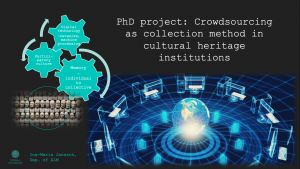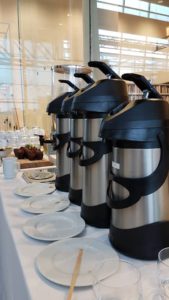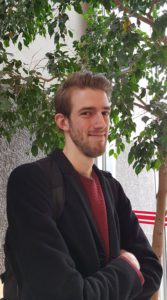This is the second part of an interview I did with John, one of our students at the Master Programme in ALM (Archives, Library and Museum Studies). The first part of the interview you can find here.
Besides talking about what the Department of ALM can offer, John and me also talked about life beyond studies. As a student it is important to have a good work-life balance, at the same time as there can be soooo much that one have/want to do and be engaged in. John explains that life of a master student can be summarized as great freedom with great responsibility. “There are maybe three to five scheduled lectures or seminars a week, although it differs depending on different courses in the programme. One has to use the time in a responsible way, setting your own time plan.” John seems to manage that without problems, and he tells me: “I use to sit in the campus library (Karin Boye-biblioteket), where I can feel like I’m in a bubble of my own. I know that there is going to be quiet and easy to focus. But I also like to try out different study environments. Sometimes I sit at campus, other times I go to the main library building, or read in a café.”
I ask him what he thinks about the student services that are offered by the university, such as the student gym Campus 1477, study assistance services or all the different courses, workshops and lectures outside academic studies. Taking a sip of water, John answers that he knows about them but have not tried out so much of this himself. “In exception for the courses in information seeking offered by the library. I have attended that course several times, actually, it’s very useful and you learn how to best use the library resources”
We talk some more about campus Engelska parken. This is the site for the Department of ALM and also where most of our teaching takes place. “Compared to other campus of Uppsala University, Engelska parken is more intriguing and interesting. I especially like Physicum, the building where the old Department of Physics used to be, but the university main hall as well. Both are old but beautiful buildings, on the outside as well as on the inside.” The buildings John refers to are built in the 17thand 19thcentury and I ask him how he believes those historic milieus contributes to his studies. “Well, I’m not sure that they effect my studies… But they make me feel…part of something greater, in a way. It feels…authentic. The long history of the university is materialized through those buildings and their surrounding.”
However, old architecture cannot make up for good friends (even if you are found of history) and I ask about social life and activities. John told me earlier that he is from Visby, but came to Uppsala when he was 19 and I wonder how he managed to adjust to a new city, far from family and old friends. He smiles when he explains that “…there is so much to do on the side of your studies while being a student! If you are new in the city, there is easy to meet new people that are in the same situation as yourself, and you can quickly find new friends and nice people to hang out with.” He continues; “I would really recommend to engage in one of the thirteen student nations (social clubs for students with their own estates, businesses, activities, scholarships, and housing opportunities). You can get working experience and learn new skills, beside your academic studies.”
Another thing that John recommends for new students is to join the student association that is connected to your programme of study. For example, at the department, we have Studierådet för ABM, which offers students a way to influence their education but also to arrange social activities like quiz nights. “When I was a student in history we had our own association which I was, and still am, very engaged in. We arranged a welcome party for new students and lots of other fun stuff. We also invited guest lecturers of our own choice, in co-operation with the department.”
Overall, I got the impression that John is content, both with his studies at the Department of ALM and with the university. Maybe a bit too content? I ask him if there is anything he is critical about or thinks should be changed. He gives it some thought, but no, nothing in particular, he says. I just nod, hoping it is an honest answer and that he is not only being polite. At the department, me and my colleagues all try to give our students the best opportunities possible, and hopefully we succeed, I think to myself.
“Be open to new perspectives! For me, the programme was not as I expected, as a matter of fact, it is better!
I finish the interview by asking John about his best advice for the new students of the Master Programme in Digital Humanities. “Be open to new perspectives! For me, the programme was not as I expected, as a matter of fact, it is better! One reason are the courses in programming and databases. Some people don’t appreciate them, they do not perceive it as something that they chose to study or see the relevance of it, but for me they gave new perspectives on information and museum studies.”


 At the Department of ALM, we try to encourage our students to travel to conferences, workshops and meeting so that they also can get important academic- or work connections for their future career. Every semester a number of students get grants from the department for going away. We have sent students to UK, Estonia, Argentina, Finland, Germany…. Many of them have shared their experiences in the department journal,
At the Department of ALM, we try to encourage our students to travel to conferences, workshops and meeting so that they also can get important academic- or work connections for their future career. Every semester a number of students get grants from the department for going away. We have sent students to UK, Estonia, Argentina, Finland, Germany…. Many of them have shared their experiences in the department journal, 